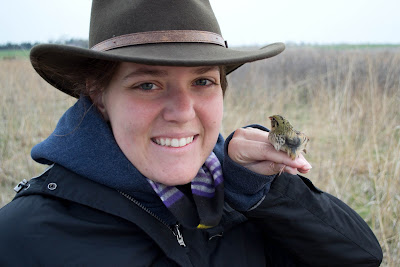I had a very interesting couple of weeks. The main thing I learned is that my little car is not made for backcountry gravel roads. I started fishtailing one morning when I had to drive myself to work and my car decided that sideways was the best way to orient itself on the road. But I was fine, and so was my car. And 200 meters later the country struck again as I had to wait for a pair of cows to remove themselves from my path. I think from now on I'll stick with riding in Levi's truck, or driving on blacktop as long as possible.
I've also learned that Missouri's idea of spring is different than Texas'. It is cold. I'm not sure why it's cold, as it's halfway through April, but for the past several days I've worn 3 coats to work. My apartment is also chilly, as I have no central heating and my window is fitted wonky so the breeze slips in. This sudden attack of cold isn't just bad for me though, it has also made the birds stop singing. Probably because they have more sense than I and hunker down in the mornings to avoid the evilly cold wind. Despite the birds hiding we still managed to catch a few cool things these past 2 weeks, some in very odd ways.
 |
| This is a Female Red-Winged Blackbird, She wanted out of my hand. |
 |
| She was being very rude to me, but I did take her away from all the males. |
 |
| She heard the Male flying around us and calling. |
 |
| This is probably one of the better flying away photos I've taken. |
 |
| Eastern Meadowlark. These are the loudest birds on the prairie right now. |
 |
| This one slammed into the net while we were chasing a Henslow's. I love the feather-fro. |
 |
| A Sora Rail, which are wetland birds that don't really belong on the Prairie. |
 |
| They look very Dinosaur-y to me. |
 |
| Loggerhead Shrike, I almost fell out of the truck window taking pictures of it. |
 |
| Oddly there are quite a lot of Deer in the tall grass, more than I've seen in the woods. |
 |
| Once they caught sight of me they vanished. |
 |
| Same Loggerhead Shrike. Though this time I almost fell out backwards. |
 |
| Kildeer sitting on its nest on the edge of a gravel parking lot. |
 |
| (S)He popped up as soon as I got to close to their nest. |
 |
| And then tried to lead me away by pretending they had a broken wing. |
 |
| Kildeer eggs, not the biggest eggs, but much larger than a Henslow's. |
 |
| They really really wanted me to chase them and leave their nest alone. |
 |
| Close up of the eggs. |
Right as we were about to leave the poor Kildeer alone we were distracted by a flock of 40 or so Pectoral Sandpipers. Normally this isn't a big deal, as we see flocks of random birds everyday, but these birds did something odd. The entire flock flew straight into a power line and we saw a few unlucky birds drop. Apparently the flock as a whole needed to visit the eye doctor. We set off running to see if we could find the fallen birds and succeeded in finding two. The first bird was mostly okay, he was groggy and bleeding from a minor puncture wound, but otherwise alive. The second bird we couldn't tell, as he was on the other side of a barbed wire fence. I decided to risk it and rolled under the fence to go get him. Sadly he'd had his head remodeled by the power line, and hadn't survived the fall. Currently he's in our freezer until we can turn him in to be made into a specimen for Emporia's museum.
 |
| This is our survivor, he was pretty out of it, but I would be too if I slammed into a wire. |
 |
| He's holding out his wing because he feels off balance. |
 |
| Poor guy probably had a headache. |
 |
| After trying our best to soak up the blood we let him go in a field to recuperate. |
 |
| He was still a bit off-balance. |
 |
| But he got back up and wandered a bit before laying down to rest. Hopefully he's alright. |
This weekend I'm hoping to get a chance to go out and see the Bald Eagle nest and Pileated woodpecker nest. But I make no promises as it's supposed to rain starting tonight and lasting until monday.





















































